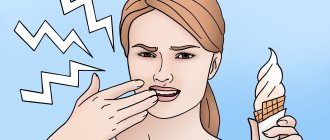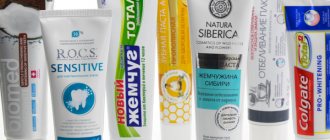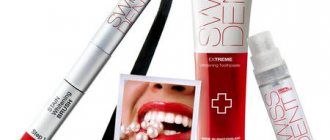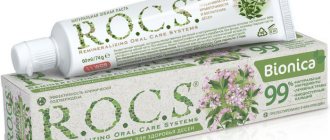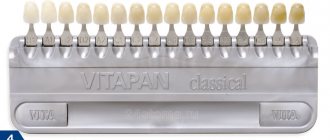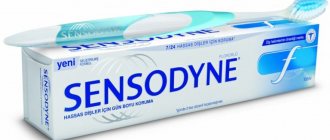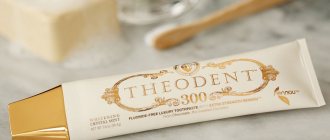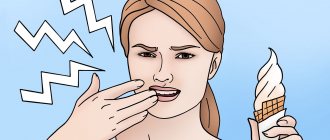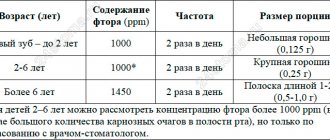Increased sensitivity of teeth (hyperesthesia) is a short-term occurrence of pain under the influence of temperature, chemical or mechanical irritating factors. Usually occurs when drinking cold water, sour, sweet, salty, or touching with a toothbrush. The intensity of pain varies from mild to unbearable.
According to WHO, every second person in the world suffers from hypersensitivity. In Russia it is about the same: 45–65% of adults aged 20–55 years. More often women make complaints.
A little anatomy
A tooth consists of a crown and root part, connected by a neck. The coronal part is covered with enamel, the root part is covered with cement. Beneath the enamel and cement there is dentin, a hard tissue. Inside there is soft tissue - the pulp; blood vessels and nerves pass through it.
Dentin is not sensitive, but consists of many tubules in which fluid circulates. The irritant causes fluid movement, which is detected by the nerve endings of the pulp. A person feels their reaction as pain.
6 Mexidol Sensitive
An interesting and effective paste for hyperesthesia. The first thing to remember is that you can use this paste for no more than a month. To determine whether a lift is suitable or not, you need to consult a dentist. It is based on the component Mexidol, which reduces pain more actively than other substances. It also has a long lasting effect. Mexidol increases the resistance of teeth to infections, improves blood circulation and relieves inflammation. The composition also contains xylitol, which stabilizes the acid-base balance of the oral cavity.
The main effect of the paste is to restore weakened or damaged enamel. The second feature is the lowest abrasiveness. There will be minimal damage to your teeth during brushing and little to no wear will be caused to your teeth. The main effect of the drug occurs due to the analgesic effect of components that affect nerve fibers. Therefore, the effect can be noticed almost immediately. The paste can be used not only for cleaning, but also for application to dental tissues with which problems arise. It is worth remembering that the product is not recommended for children under 12 years of age and pregnant women.
Tooth sensitivity: causes
- Demineralization of enamel. It becomes more loose due to the leaching of calcium, phosphorus, and other trace elements.
- Thinning of enamel. As a result of increased abrasion due to malocclusion and the occurrence of wedge-shaped defects.
- Untreated caries or violation of the marginal seal of the filling.
- Exposure of roots as a result of injury, metabolic-dystrophic process or inflammation of the gums.
- Changes in the pH of saliva due to the consumption of certain drinks, foods, and medications. A pH of less than 5.5 is considered dangerous.
- Some diseases accompanied by gastroesophageal reflux and endocrine disorders.
- Vitamin deficiency, exposure to radiation, work in hazardous industries, living in a region with an unfavorable environmental situation.
- Smoking.
More often than not, several reasons are discovered at once. The enamel becomes thinner, loses strength, and cannot protect dentin from irritants. The result is pain.
Sensodyne instant effect
This toothpaste, as the name “instant effect” already implies, gives noticeable results after the first use. This is the type that dentists recommend for severe pain. When used, the instant effect toothpaste forms a protective layer on the surface of the teeth that protects hypersensitive enamel from irritants.
It can be used after treatment as a pain reliever by rubbing a small amount onto the tooth for one minute. After this, sensitive teeth are not afraid of hot tea, sour juice, or sweet cake.
In addition, the paste has a wound-healing and anti-inflammatory effect if there are wounds and abrasions in the mouth, which means that it is very well suited for oral care for stomatitis or gingivitis. This paste is also not recommended for use by children under 12 years of age; after using it, you should rinse your mouth thoroughly.
Provoking factors
Hyperesthesia does not appear immediately. There are several factors that you need to pay attention to in order to eliminate them in time. Don't wait for discomfort to appear. It is better to initially develop healthy habits that will help you maintain your health so that you never experience acute dental pain. Sensitivity increases when any of the factors listed below are present.
- Insufficient oral hygiene. Soft plaque is an accumulation of microbes that eat food microparticles stuck in crevices, releasing organic acids that dissolve enamel minerals. Externally, the dental unit looks intact, but the density of the enamel is significantly reduced. Its demineralization occurs. The first alarm bell is increased sensitivity, then caries develops.
- Consumption of certain foods. Juices, wine, sweet soda, fruits, candies, and other sweets contain phosphoric and other acids that negatively affect the strength of enamel.
- Constant use of aggressive whitening pastes containing abrasive and chemical components.
- Ultrasonic cleaning. Under a dense coating, the enamel becomes thinner and becomes loose. After professional cleaning, it is exposed, its sensitivity increases sharply. Usually, dentists, taking this point into account, use strengthening pastes at the end of the procedure for the preventive treatment of tooth sensitivity.
Using toothpaste for sensitive teeth during pregnancy
During pregnancy, 90% of expectant mothers face the problem of tooth sensitivity. Toothpaste for the treatment of the disease should eliminate discomfort and not contain components that can harm the fetus. It is advisable to purchase the product only after agreement with the treating dentist.
Some manufacturers produce pastes specifically for use during pregnancy:
Advantages of these pastes:
- They do not contain ingredients that can harm the health of the mother and unborn child.
- Effectively combat the problem of tooth sensitivity.
- Prevents the appearance of plaque on tooth enamel.
- They have a pleasant refreshing effect.
- Prevents the appearance of inflammatory processes in the gums.
- They contain low-foaming components that do not allow calcium to be washed out of tooth enamel.
- They have a remineralizing effect.
Types of hypersensitivity
If sensitivity is increased on one or more teeth, it is called limited. If for everyone - generalized.
Table 1. Types of hyperesthesia
| № | View | Reaction |
| 1. | Light | for cold, hot |
| 2. | Average | as with 1st degree plus for sour, sweet, salty |
| 3. | Expressed | as in grade 2 plus mechanical irritants (when brushing teeth, eating) |
How does dental hypersensitivity manifest?
A person will immediately recognize that tooth sensitivity has increased. The main symptom is acute short-term pain lasting 10-30 seconds. Pain may occur locally or affect the entire dentition.
Doctors distinguish three stages of hyperesthesia:
- First, enamel reacts to temperature: hot/cold;
- The second is a reaction to changes in acidity: sweet, salty, spicy;
- Third, teeth react to any irritants, including light touches.
Sensitivity of teeth. Stages of treatment
- Eliminate the cause of hyperesthesia: get rid of plaque, deposits, stones, caries, wedge-shaped defects.
- Carry out professional oral hygiene.
- Strengthen the enamel with calcium and fluoride.
- Teach the patient how to use a toothbrush and floss correctly.
- Choose suitable dental care products: toothpaste, mouthwash.
Table 2. Tooth sensitivity: causes and how to treat
| № | Cause | What to do |
| 1. | Soft coating. | Careful hygiene with home remedies. |
| 2. | Hard coating. | Professional hygiene in dentistry. |
| 3. | Caries in the white spot stage. | Deep fluoridation, remineralization. |
| 4. | Caries, pulpitis, periodontitis. | Dental treatment. |
| 5. | Exposure of the cervical part, wedge-shaped defect. | |
| 6. | Malocclusion. | Orthodontic therapy. |
Summary
- If hypersensitivity occurs, avoid drinks and foods containing acids (fruits and fruit juices, wine, etc.).
- If you have previously used whitening toothpastes, stop using them, because... with a high probability, hypersensitivity is caused precisely by their use.
- Consult your dentist about the cause of sensitivity - it may be caused by caries or exposed tooth necks. Remember that caries in the form of a white spot is a reversible form of caries, and if you undergo remineralization therapy on time, you will not only get rid of increased sensitivity, but also prevent the destruction of this area of enamel.
- If there are dental deposits, they must be removed, followed by a course of remineralization and/or deep fluoridation.
- Maintain proper oral hygiene - cariogenic microflora in the cavity, feeding on food debris, produces acids that wash calcium from the enamel and lead to the appearance of both hypersensitivity and dental caries. Check out the link above for comprehensive hygiene tips, as well as videos on proper brushing and flossing techniques.
Sources:
1. Higher professional education of the author in dentistry, 2. Personal experience as a dental therapist, 3. National Library of Medicine (USA), 4. The European Academy of Paediatric Dentistry (USA), 5. “Therapeutic dentistry. Textbook" (Borovsky E.).
Elimination of tooth sensitivity
Using ultrasound, the doctor removes soft and hard deposits from the teeth. After removing plaque, teeth become more sensitive for a short time, so remineralization or deep fluoridation is immediately carried out. During remineralization, the enamel is treated with active compounds of calcium and phosphates. Deep fluoridation – coating with sodium fluoride. Both procedures significantly strengthen the enamel's resistance to irritants.
The doctor uses agents that reduce the movement of fluid in the dentinal tubules. It “seals” them using desensitizers or reduces their volume through remineralization. Protecting exposed dentin reduces the force of transmission of the irritant impulse from the enamel to the nerve.
What to do if you lose tooth enamel?
The problem is not always solved by remineralization and dental varnish. In cases where the enamel is worn out or severely cracked, gentle methods will not help. Modern dentistry offers several solutions with complete or partial preservation of the tooth:
- Veneers and lumineers are the most expensive method; they provide good protection, but do not restore chewing functions.
- Ceramic or zirconium crowns are strong and durable. Requires preliminary preparation of the support.
- Artistic restoration - new generation composite materials are practically indistinguishable from the natural shade, but last a maximum of 10 years.
Basic points of proper hygiene
Use a synthetic, medium-hard or soft brush. Change it every three months.
The toothpaste should be suitable for very sensitive teeth. Typically, such products contain hydroxyapatite, strontium chloride, fluorides, potassium nitrate, or a combination of calcium carbonate and arginine.
Take enough paste. For children under 3 years old - the size of a grain of rice, from 3 to 14 years old - the size of a pea, for adults you need to squeeze out about one centimeter.
Brush your teeth for 2 minutes: 30 seconds on each surface, top and bottom. Monitor time using an hourglass or mobile phone timer. Electric toothbrushes emit a short beep every 30 seconds and a long beep every 2 minutes from the start of brushing.
Which desensitization paste to choose for a child?
The delicate enamel of baby teeth requires special delicate care. Children's toothpaste should not contain SLS, parabens, or titanium dioxide. If the paste foams a lot, it means that it contains SLS, and it is better to discard it.
It is important that the amount of abrasives is minimal (RDA - from 0 to 20).
Children's toothpaste should contain a small amount of fluoride: up to 4 years - 200 ppm, from 4 to 8 years - 500 ppm.
It is very important that the paste is not only effective and safe, but also tasty. This will help your baby learn to brush their teeth regularly.
Cleaning sequence
- Using sweeping movements, clean the outer and then the inner surfaces of the bottom row. Move from molars to incisors. Then do the same on the top row. Hold the brush at a 45-degree angle and do not use a sawing motion. This leads to damage to the enamel.
- Brush chewing surfaces with small circular movements.
- Close your jaws and walk along your gums in a circular motion.
- Brush your tongue using a leisurely four to five strokes from root to tip.
- Treat the interdental spaces with dental floss.
- Rinse your mouth.
It is more effective to clean with an electric brush or irrigator. The quality of hygiene increases 3–4 times. Hyperesthesia can be dealt with faster.
Is it possible to strengthen sensitive teeth at home?
Yes. If you can’t get to the dentist, you can try to help yourself. There are several remedies that can solve the problem of hyperesthesia at home.
Table 3. Popular products for home use
| № | Name | Mechanism of action | Age category |
| 1. | ROCS Medical Minerals, GC Tooth Mousse | Remineralizing gels | Adults and children |
| 2. | Colgate Duraphat 2800 ppm | Fluoridating paste | 10–15 years |
| 3. | Colgate Duraphat 5000 ppm | From 16 years old | |
| 4. | ELMEX junior | Fluoridating paste | 6–12 years |
| 5. | ELMEX | From 13 years old | |
| 6. | LACALUT Extra Sensitive | Paste that reduces tooth sensitivity | For adults |
| 7. | Colgate Sensitive Pro-Relief | ||
| 8. | PRESIDENT Sensitive | ||
| 9. | LACALUT Sensitive, 300 ml | Rinse for sensitive enamel | From 15 years old |
Children's products for sensitive teeth
Criteria for choosing children's toothpaste:
- The fluoride concentration in the product should not exceed 1%.
- The paste should have a soft structure and not contain abrasive particles that can damage the child’s immature tooth enamel.
- It is necessary to choose a product that does not contain active chemical components. Otherwise, the baby may be poisoned or have an allergic reaction if the toothpaste is accidentally swallowed. These components include: saccharin and sodium lauryl sulfate.
- Many manufacturers make a mark on the product that allows you to choose a paste that is appropriate for the child’s age.
Algorithm of actions for hyperesthesia
- Adjust your diet. Avoid completely or significantly reduce the consumption of foods and drinks containing acids and sugar. Especially fruit and berry juices, wine, candies. Eat more green vegetables, fiber-rich foods, and whole grains.
- Change your toothpaste. Never use bleach. Choose from those labeled "Sensitive".
- Check if you are practicing proper oral hygiene. If it's wrong, correct it.
- Make an appointment with your dentist to find out the type of tooth sensitivity, find out the cause and get treatment.
- Visit the dentist twice a year, even if nothing hurts.
Toothpastes and rinses
You can also reduce tooth sensitivity at home using special toothpastes and rinses.
- Oral-B Sensitive Original.
- Sensodyne-F.
- MEXIDOL dent Sensitive.
- Rembrandt Sensitive.
Pastes to reduce tooth sensitivity should be used during hygienic cleaning of the oral cavity, 2 times a day, morning and evening. To achieve a positive result, it is better to use them in a course – 1 – 2 times a year.
Important to remember! Therapeutic pastes, like varnishes, gels, powders and foams, are effective only in the absence of dental diseases.
Do not ignore preventive visits to the dentist.
It is enough to visit a specialist 1 – 2 times a year, which will allow you to promptly identify any dental problem at an early stage of development. This means that its elimination will be quick, easy and without complications.
By clicking the “request a call” button you agree to the personal data processing policy.
Treatment of hyperesthesia in the “Family Doctor”
If hyperesthesia occurs, make an appointment with a dentist by calling the contact center in Moscow +7 (495) 775 75 66 or using the online appointment form. Our clinic has been operating for more than 25 years. Experienced doctors help patients cope with pressing problems, including hypersensitivity.
The doctor will find out the cause of tooth sensitivity and provide effective treatment. In most cases, it is enough to select suitable oral care products and carry out proper hygiene procedures. In more complex situations, full treatment is used, and if necessary, surgical treatment.
The clinic takes a gentle approach to patients. All procedures are accompanied by adequate pain relief, which eliminates the occurrence of discomfort and pain. Increased sensitivity of teeth is not just a feature of them. This is the beginning of a disease that must be cured. And it's better to do it as quickly as possible.
Treatment at the dentist
In most cases, hyperesthesia is caused by dental diseases. Therefore, it is not possible to get rid of the problem using home remedies or traditional medicine advice. In this case, home measures only aggravate the course of the pathology and lead to the progression of dental diseases.
You should not postpone a visit to the dentist even if there are minor manifestations of pain due to external stimuli. Modern medicine has effective methods for treating any dental ailment. After a thorough diagnosis of the condition of the teeth, an experienced specialist will accurately determine the cause of increased sensitivity and carry out the necessary treatment. This may be the elimination of wedge-shaped tooth defects, treatment of caries, periodontitis, pulpitis or erosion of tooth enamel. In the absence of serious diseases, the dentist can perform a competent procedure for remineralization of teeth, which will strengthen tooth enamel and relieve hypersensitivity.
Hypersensitivity is not a dental disease, but rather a symptom indicating the presence of dental disease. And the sooner you contact a specialist, the greater the chance of maintaining the health and integrity of your teeth.
